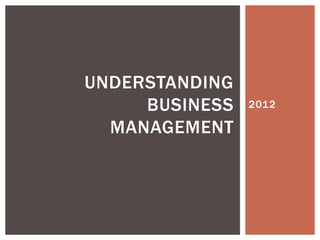Buma combining 3 sources
- 1. UNDERSTANDING BUSINESS 2012 MANAGEMENT
- 2. LEARNING UNIT 1 TOPIC MODULE INTRODUCTION TO BUSINESS ADDENDUM GUIDE MANAGEMENT 1A Management roles in p. 19 p. 24 (2.1) p. 14 â 15 business environment Business process p. 17 p. 5 â 9 Management roles at p. 18 pp. 17, 32, 34 p. 9 â 12 different levels The importance of pp. 14, p. 24 p. 19 management in 16 business Management tasks in p. 15 business Skills needed by p. 36 (Leadership skills) p. 12 â 13 managers
- 3. LEARNING UNIT 1 TOPIC MODULE INTRODUCTION TO BUSINESS ADDENDUM GUIDE MANAGEMENT 1A Major challenges for p. 16 - 17 p. 45 p. 20 - 21 SA managers Differences between p. 15 â 18 leadership & management Factors of production p. 5 â 6 (1.1.3) â both input and output Relationship between p. 14 factors of production and managerial functions
- 4. LEARNING UNIT 2 TOPIC MODULE GUIDE INTRODUCTION TO BUSINESS ADDENDUM MANAGEMENT 1A Different economic p. 31 â 33 p. 7 â 9 p. 22 â 34 systems (excl. P. 31 â 33) Effect of economic p. 10 system on organisation Impact of p. 31 â 33 government policies on SA business Different business p. 33 â 35 p. 10 â 13 environments Differentiate between p. 33 â 35 p. 11 (Fig. 1.2) different business environments
- 5. LEARNING UNIT 3 TOPIC MODULE GUIDE INTRODUCTION TO BUSINESS ADDENDUM MANAGEMENT 1A Define p. 40 p. 50 p. 34 â 35 entrepreneurship List & describe p. 50 â 52 p. 36 â 37 characteristics of an entrepreneur Identify the different p. 53 - 54 p. 37 - 38 types of entrepreneur
- 6. LEARNING UNIT 4 TOPIC MODULE GUIDE INTRODUCTION TO BUSINESS ADDENDUM MANAGEMENT 1A What is meant by p. 46 (2.2) p. 54 (3.2) âsmall businessâ Formal & informal p. 44 (4.4) sectors of economy Role that small p. 46 (2.3) p. 45 (4.5) business plays in SA List 5 small business p. 47 (2.5) p. 42 â 43 support initiatives (4.3) Describe 2 small p. 70 â 71 (3.8.2) p. 42 â 43 business support (4.3) initiatives
- 7. LEARNING UNIT 4 TOPIC MODULE GUIDE INTRODUCTION TO BUSINESS ADDENDUM MANAGEMENT 1A Distinguish between p. 62 (3.5) p. 40 â 42 various categories of (4.2) small businesses Classify challenges p. 46 (2.4) p. 56 (3.2.2); p. 69 (3.7) p. 45 (4.6) faced by small business
- 8. LEARNING UNIT 5 TOPIC MODULE GUIDE INTRODUCTION TO BUSINESS ADDENDUM MANAGEMENT 1A Various types of p. 52 â 55 (2.2) p. 62 â 67 (3.5) business ownership Advantages & p. 52 â 55 (2.2) p. 62 â 67 (3.5) disadvantages of each form Distinguish between p. 62 â 67 (3.5) each form of ownership
- 9. LEARNING UNIT 6 TOPIC MODULE GUIDE INTRODUCTION TO BUSINESS ADDENDUM MANAGEMENT 1A What is a feasibility p. 58 - 67 study? Evaluate the three p. 59 - 60 p. 47 â 52 approaches to owning (6.1 â 6.4) a small business Decide on p. 52 â 58 opportunities for small business development Consider factors that p. 58 - 67 will be used to do a feasibility study
- 10. LEARNING UNIT 7 TOPIC MODULE GUIDE INTRODUCTION TO BUSINESS ADDENDUM MANAGEMENT 1A Explain the p. 67 (7.1) importance of strategic management Distinguish between p. 77 (4.2) p. 68 - 69 the different levels of (7.2) strategy Select the most suitable strategy for a given scenario









